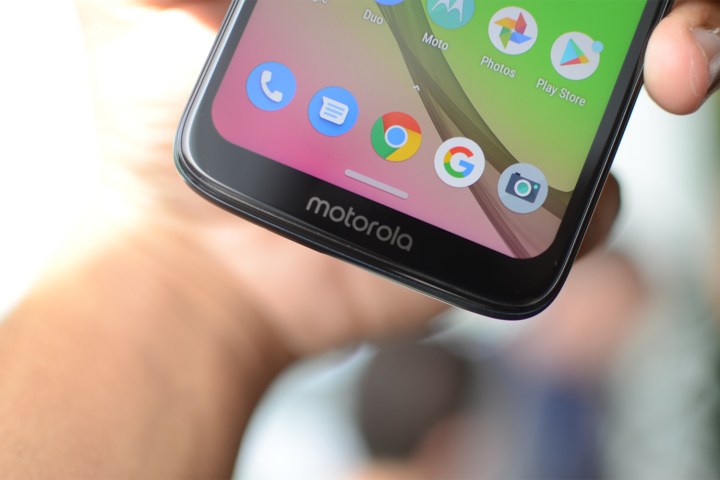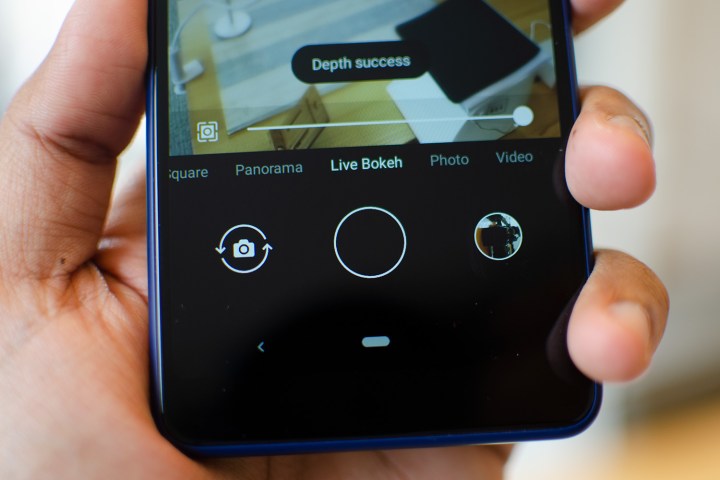
Getting a great phone doesn’t always mean spending a lot of money, and we love finding the best budget phones around to recommend to people who either don’t have the cash to splash, or simply don’t need all the features a flagship offers. Motorola and Nokia have built new empires on the cheap phone market, and with the release of the new Moto G7-range, it’s time to revisit this old rivalry. The Moto G7 Play is the cheapest of Motorola’s new phones, with a powerful new processor and a great new look. But the Nokia 3.1 Plus is no slouch either. Which phone wins when these two go head to head? We found out.
Specs
| Moto G7 Play | Nokia 3.1 Plus | |
| Size | 148.7 x 71.5 x 8.19 mm (5.85 x 2.81 x 0.32 inches) | 162 x 77 x 8.78 mm (6.38 x 3.03 x 0.35 inches) |
| Weight | 151 grams (5.3 ounces) | 190 grams (6.70 ounces) |
| Screen size | 5.7-inch IPS LCD | 5.99-inch IPS LCD |
| Screen resolution | 1512 x 720 pixels (294 pixels per inch) | 1440 x 720 pixels (268 pixels per inch) |
| Operating system | Android 9.0 Pie | Android 9.0 Pie |
| Storage space | 32GB | |
| MicroSD card slot | Yes, up to 512GB | Yes, up to 256GB |
| Tap-to-pay services | No | Google Pay |
| Processor | Qualcomm Snapdragon 632 | Qualcomm Snapdragon 439 |
| RAM | 2GB | |
| Camera | Rear 13MP, front 8MP | Dual 13MP and 5MP rear, 8MP front |
| Video | 1080p at 30 frames per second | 1080p at 30 frames per second |
| Bluetooth version | Bluetooth 4.2 | Bluetooth 4.1 |
| Ports | 3.5mm headphone jack, USB-C | 3.5mm headphone jack, USB-C |
| Fingerprint sensor | Yes | Yes |
| Water resistance | Water-repellant coating | No |
| Battery | 3,000mAh
10W fast charging |
3,500mAh
QuickCharge 3.0 |
| App marketplace | Google Play Store | Google Play Store |
| Network support | T-Mobile, AT&T, Verizon, Sprint | Cricket Wireless, AT&T, T-Mobile |
| Colors | Starry Black, Deep Indigo | Blue, White, Gray |
| Price | $200 | $160 |
| Buy from | Motorola | Cricket Wireless, Amazon |
| Review score | Hands-on review | Full review |
Performance, battery life, and charging

While budget phones are less powerful than more expensive phones, that doesn’t mean lumbering yourself with a slow phone. The Nokia 3.1 Plus comes with the Snapdragon 439 processor, and it provides good enough performance. You won’t be playing any modern games on it, and it did take some time to open apps in our testing, but it otherwise did well enough. However, it can’t compete with the more powerful Snapdragon 632 in the G7 Play. Motorola boasts that the 632 is 110 percent more powerful than the Snapdragon 430 in last year’s G6 Play. The performance was snappy, and apps opened quickly during our limited testing.
Both phones have batteries that should easily make it through the day and into a second, but you’ll probably need to charge both before the day is out. They’ll both recharge quickly too, though the Nokia 3.1 Plus’s QuickCharge 3.0 is likely superior to Motorola’s 10W TurboPower.
The Nokia 3.1 Plus’s larger battery and the inclusion of NFC for Google Pay payments give it an edge, but the pure power of the G7 Play sets it apart from other budget phones.
Winner: Moto G7 Play
Design and durability

The design of the Nokia 3.1 Plus was one of the elements we liked most about the phone in our hands-on review. It has a reassuring weight, it feels tough, and it sits nicely in your hand. It’s made from polycarbonate, but it doesn’t feel cheap thanks to the heft. On the minus side, it’s a little on the large side, and those with smaller hands may struggle to reach the top of the screen. The Moto G7 Play is pretty much the opposite. It feels cheaper than its G7 family members, due to the resin back panel and much lighter weight — but it’s a much smaller package, with much slimmer bezels. If you’re a fan of smaller phones, then you’ll dig this design.
As with most budget phones, you won’t find any water-resistance here, though the G7 Play does sport a “water-repellent” coating. Rain won’t be a worry, but it’s not going to survive a drop in the pool. Both should be fairly physically durable, but we still recommend a case, as always.
It’s a tough call to make here, but we’re going to make the case that the Nokia phone’s nicer build beats the Moto G7 Play’s sleeker style.
Winner: Nokia 3.1 Plus
Display

The display is something of a weak point for both phones. The Moto G7 Play comes with a 5.7-inch LCD display running a 1512 x 720-pixel resolution, while the Nokia 3.1 Plus has a 5.99-inch LCD display with a 1440 x 720-pixel resolution. The G7 Play’s slightly smaller screen means a slightly sharper display, but it’s such a small difference we’re not sure if you’d see it, even holding them side by side. Both are colorful, but on the dim side, which makes seeing them outside tougher than you’d expect.
Both displays are OK, but a bit disappointing. It’s a tie.
Winner: Tie
Camera

Budget phones often misstep on their cameras, and honestly, it’s an acceptable place to find savings in a budget phone. The Nokia 3.1 Plus comes with a dual 13-megapixel and 5-megapixel lens around the back, with an 8-megapixel lens around the front. The Moto G7 Play only has a single 13-megapixel lens around the back, but it comes with an 8-megapixel selfie lens too. We haven’t had much chance to play with either of these yet, but we expect both will share the same downfalls, struggling in lower light while doing well enough in stronger light.
In theory, the second rear lens on the 3.1 Plus gives that phone an edge, but it’s probably not quite that simple in practice, thanks to the G7 Play’s additional features. High-res Zoom claims to give a strong digital zoom, while the Hyperlapse feature allows you to make cool time lapse videos. The G7 Play also has Portrait Mode on both cameras, making this a tricky call.
We need to spend more time with both. This is a tie for now.
Winner: Tie
Software and updates

You’ll find Android 9.0 Pie on both of these phones, but both come with some additional apps — Motorola has its own apps and features installed, while Nokia was forced to drop its usual Android One to get into bed with Cricket Wireless, so you’ll find Cricket’s bloatware there. Still, the close-to-stock Android builds are quick and snappy, and there’s a lot to love software-wise on both phones.
Unfortunately, the Moto G7-range has only been confirmed to get one major Android upgrade: Android Q. While the partnership with Cricket means the Nokia phone’s upgrades are more uncertain than on Android One, Nokia has a very strong record with major Android OS updates, so we’re hoping to see two major updates on the Nokia 3.1 Plus. In our mind that gives it a hefty advantage.
Winner: Nokia 3.1 Plus
Special features

Thanks to the barebones Android version on the Nokia 3.1 Plus, you won’t find many special features outside of Google’s usual Assistant and Lens features and Cricket’s bloatware. On the other hand, Motorola has added a fair few fun features to the G7 Play. Moto Gestures is genuinely useful, and means you can chop your phone twice to turn on your flashlight, or twist twice to open the camera. Moto Display also allows for an always-on display for notifications. It’s a relatively modest raft of features, but they’re pretty good.
Winner: Moto G7 Play
Price
The Nokia 3.1 Plus is currently available from Cricket Wireless for $160, and you can buy it in blue, white, and gray. The Motorola Moto G7 Play will cost $200, and it will launch later in February. You’ll be able to pick it up from a variety of places, and it should work on most major U.S. carriers.
Overall winner: Moto G7 Play
It’s a very tough competition, and there’s still a lot to figure out with both of these phones — but at the moment, we’re leaning towards the Moto G7 Play being the stronger phone. You’ll find more power here, more special features, and a compact and attractive design that means it just pips the Nokia 3.1 Plus to the post. However, the Nokia 3.1 Plus is still a great budget phone for $40 less, and if you’re drawn to the solid build and NFC on the Nokia phone, you’re unlikely to regret your choice.


